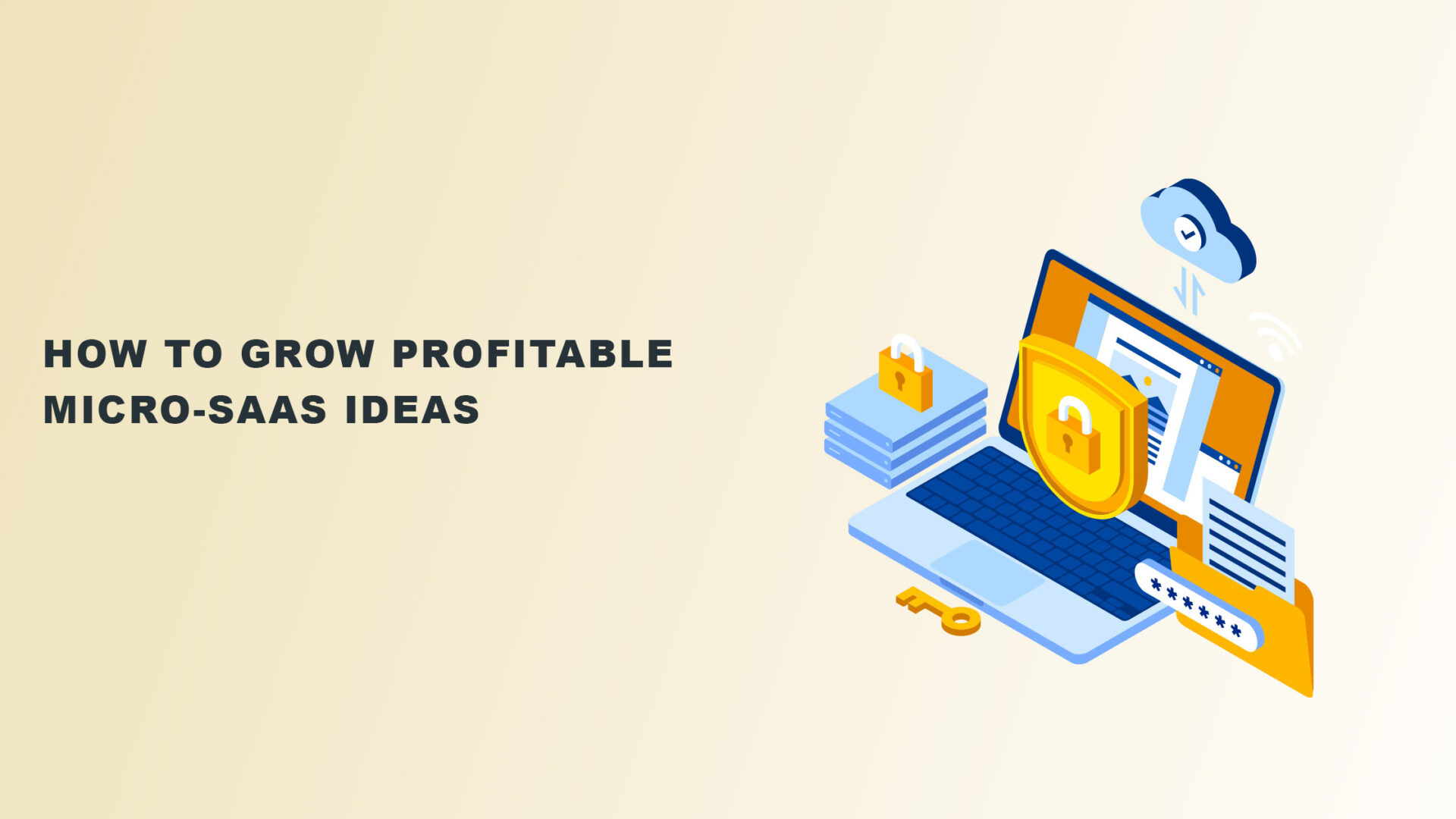The right micro-SaaS idea can create a lucrative revenue stream, but the path to having profitable micro-SaaS ideas is often riddled with pitfalls and missteps.
You need to find the right vision, team up with the right people, build it the right way, and then protect it with everything you have because there are no guarantees when starting.
We’ve put together comprehensive advice for successfully bringing your idea from its initial phase into a profitable business.
6 Proven Steps to Growing a Micro-SaaS Idea Into A Profitable Business
If you are just starting with a micro-SaaS idea, you know that it can be daunting.
But growing a micro-SaaS requires a step-by-step process with little to no guesswork.
Here is how to develop a micro-SaaS idea into a profitable business.
1. Identify Your Target Market

Target market refers to the people you want to serve and who best fit your products and services.
Identifying your target market involves making an effort to understand its requirements and motives.
You may find out what your clients require and how much they’re willing to spend by looking at demographics like age, gender, education level, occupation, and family situation.
Also, evaluate your competition to determine what products they sell to understand what problems your product can solve for your target market.
Find the correct segment of the target audience you want to serve and build the micro-SaaS based on their needs. Here’s how you can do that:
1.1 Assess the Competition and Who They’re Targeting
Assessing the competition will give you ideas on improving your micro-SaaS and help you understand where your micro-SaaS needs to add value for its customers.
Use online tools and resources like Google, LinkedIn, and industry-specific websites to find companies offering similar products or services.
Once you have identified your competitors, you can analyze their strengths and weaknesses.
This strategy can help you understand the target audience and how to approach them.
1.2 Create Customer Profiles and Market Segments
A customer profile is an individual that fits the demographic and psychographic traits of your ideal customer.
On the other hand, market segmentation is finding different ways to classify or categorize your target market to narrow down your audience.
Creating these profiles and segmentation helps you define the market you want to serve and allows for a more targeted marketing approach.
2. Verify Your SaaS Idea

Before choosing a path, you must verify that your micro-SaaS even solves a problem for the market it serves.
To grow to a profitable micro-SaaS idea, you need to measure whether the target market wants what you offer and whether the product addresses their problems.
Let’s look at some of the ways you can conduct validation.
2.1 Conduct Thorough Research
Learn all there is to know about your company by conducting research.
Professionals and entrepreneurs with experience in the micro-SaaS industry can provide valuable insights and expertise on market trends, customer needs, and best practices.
They can also share their experiences and lessons learned, which can help you avoid common pitfalls and make informed decisions.
2.2 Analyze the Competitive Market
Competitive analysis helps you assess your business idea and understand the market and its needs.
It involves looking at your competitors and comparing their services and products to yours.
You must adequately comprehend what they provide, their costs, and their USPs.
2.3 Gather Customer Feedback
Customer feedback is also helpful in validating a business idea.
Get an idea of what the public expects about your micro-SaaS by giving them a chance to say what they like about it or don’t like.
You can conduct customer surveys by email, telephone, or by asking people in person.
3. Achieve Strong Product-Market Fit

Before starting a business, you need to have a product-market fit.
It means your product has to solve a problem and be helpful to the market it is entering.
Product-market fit is essential when starting a micro-SaaS because it can help you align your goals with resources.
It involves identifying your potential customers and ensuring that there is a market for your product.
4. Get Your First Customers
Getting customers and clients is how you can earn revenue with your micro-SaaS.
The most direct way of doing this is by marketing your micro-SaaS directly to a target market.
Here are some different forms one can use in their micro-SaaS:
4.1 Use Your Network

Your network is an effective way of getting your first customer.
It consists of your business contacts who can help you by referring customers to your micro-SaaS.
They can let people know about your idea without you having to spend on advertising.
4.2 Offer Product Trials
Another effective way to get your first customer is by offering product trials.
Potential customers will be more willing to subscribe to your micro-SaaS if they first have a feel for it.
Let them test out the product so they can provide helpful feedback about how you can improve it to cater to their needs.
4.3 Invest in Content Marketing

Content marketing is a way of attracting the attention of your potential customers through digital and social media platforms.
Online content is excellent for marketing your SaaS because people love to read, and information from the web can seem more credible.
4.4 Utilize SEO Tactics
Search Engine Optimization (SEO) tactics are some of the best ways to get the attention of potential customers.
They include creating content that ranks well on search engines, earning authority backlinks with digital public relations, and conducting keyword analysis.
SEO helps you gain more traffic to your micro-SaaS and makes it easily accessible to the public.
4.5 Leverage Paid Ads

Paid ads can be a powerful tool for driving traffic and sales to your business.
They allow you to advertise your micro-SaaS and reach a broader target market by paying for their visibility on more prominent sites.
Different platforms offer different types of ads and reach different audiences.
For example, Google Ads and Bing Ads are suitable for getting people to search for specific products or services.
At the same time, social media ads can effectively target specific demographics or interests.
4.6 Employ Referral Marketing
Referral marketing is when you enlist your current customer to refer your micro-SaaS to their network and close friends.
You can ask them to spread the word through email, social media, and personal interaction.
Their trust and faith in your micro-SaaS can influence their decision to share your services and products, resulting in more potential customers reaching out to you.
5. Experiment With Pricing

In micro-SaaS businesses, there is a lot of give and take. You’ll have to get the price right to work for you and your customers.
When experimenting with pricing models, you need to determine how much value your micro-SaaS provides over other competitors’ services.
The more valuable your micro-SaaS is for your market, the higher its price point will also be.
5.1 Offer a Variety of Options
Customers are often willing to pay for a product or service in different packages.
Offer your customers several value-based pricing options that allow them to choose according to their preferences.
5.2 Use Test Anchor Pricing
By using the cost of your product as a point of comparison for its worth, you can create several products and prices to see how your customers will react to each one.
It will help you determine the best price point for your micro-SaaS idea.
5.3 Implement A/B Testing
A/B testing is a marketing experiment wherein you identify which version of your product is performing best and what customers want to pay.
A/B testing helps you understand which pricing options are most likely to convert and which customers will reject.
5.4 Use Charm Pricing
Charm pricing, also known as psychological pricing, is a pricing strategy that involves setting prices at certain levels that are believed to be more attractive to consumers.
For example, you might price a product at $49.99 instead of $50 or $999 instead of $1000.
The idea behind charm pricing is that consumers will perceive these prices as being more appealing and more affordable, which can lead to increased sales.
6. Scale Your SaaS Business
Scalability is the ability to expand and possess enough resources to continue thriving even when business is slowing down or potentially failing.
Describe your company’s nuanced demands in greater detail to draw potential clients farther into the sales cycle.
Here are some of the sectors in your micro-SaaS business that you need to consider to scale up.
6.1 Offer Self-Serve Onboarding
Self-serve onboarding processes allow your customers to integrate their micro-SaaS into their current systems and processes.
It will enable them to get used to your products and services even before establishing a contract with you.
Potential customers will be more likely to try out your services if they don’t have to wait for you to get involved.
6.2 Address Retention and Churn

If customers leave your micro-SaaS, they will likely never return.
Some possible reasons include billing and service issues, no longer needing the product or service, and the value of your micro-SaaS not being up to par.
To retain customers, you need to identify the issues that cause churn and fix them as soon as possible.
6.3 Provide Customer Support
Provide the customer with various support options to serve them better.
It can include a customer service line, live chat, email, and social media channels.
Customers can contact you at their convenience and will feel that your micro-SaaS is more accessible and trustworthy.
6.4 Be Adaptable to Market Changes

It’s essential to adapt to market changes.
Adaptability will enable you to take advantage of them and increase your revenue.
It can include increasing or decreasing the price of your products and services, introducing new features and functionality, or creating exclusive deals for existing customers.
Final Thoughts on Profitable Micro-SaaS Ideas
Growing your micro-SaaS ideas into profitable ones means having the right tools, techniques, and strategies.
The more you understand how your customers perceive your micro-SaaS and what’s most attractive to them, the easier it will be to scale up your business.
It’ll ensure you can attract new customers and retain current ones for a better overall experience.
Here’s an example of how Simon Hoiberg, a Software Developer and Tech Entrepreneur, created a profitable micro-SaaS idea in more or less two months.

